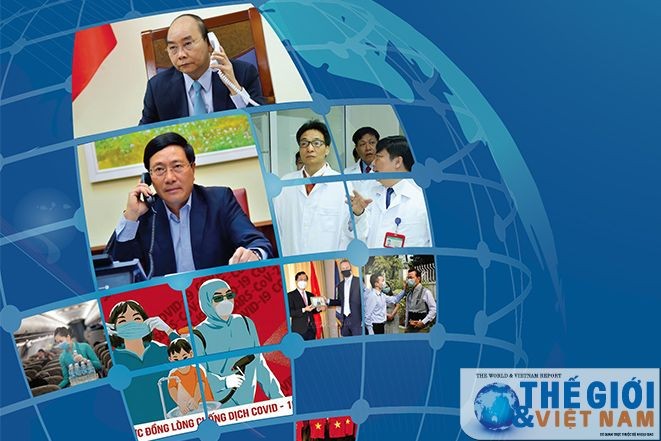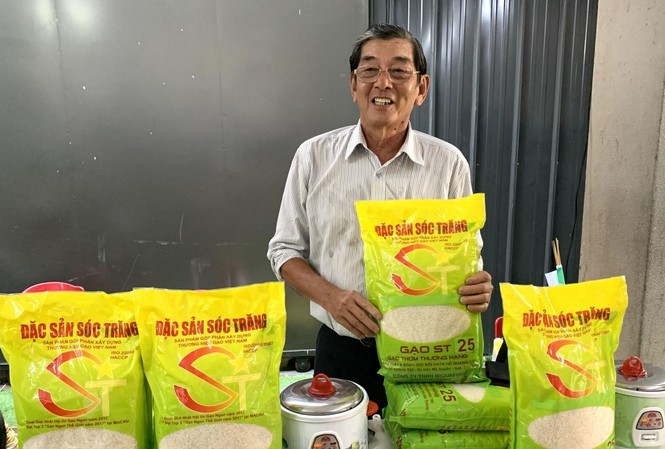B: We’re very surprised with listeners’ investment in their answers to our question.
A: Most of the entries praised Vietnam’s success in containing the COVID-19 pandemic saying the country has become a spotlight of hope for the global fight against the pandemic. The listeners said it was thanks to the Vietnamese government’s resolute, prompt measures in quarantine, social distancing, and testing, particularly in epicenters. They said the Vietnamese government’s response reflects its respect for people’s lives and health embracing humanity.
 COVID-19 patients are discharged from hospital (Photo: VNA) COVID-19 patients are discharged from hospital (Photo: VNA) |
B: Xue Fei, a listener of the Chinese Service, wrote: “In the fight against COVID-19, all measures taken by Vietnam are based on the principle of protecting people, reducing transmission and infection, and doing the utmost to save people’s lives. As soon as the epidemic occured, the Vietnamese government maintained the view of ensuring transparency and upholding responsibility in updating the disease situation inside and outside the country, promptly sharing outcomes of vaccine research, increasing cooperation with international friends, keeping regular contact with the World Health Organization, and sharing disease prevention experiences with other countries.”
 Vietnam Red Cross volunteers instruct people how to wash hands in a proper manner to prevent COVID-19 (Photo: danvan.vn) Vietnam Red Cross volunteers instruct people how to wash hands in a proper manner to prevent COVID-19 (Photo: danvan.vn) |
A: Paul Jamet, a listener of the French service commented: “Vietnam always respects people’s health. To know more about it, you just need to look at Vietnam’s healthcare system, particularly Vietnam’s all people health insurance policy. In ASEAN, Vietnam is the country that spends most on people’s health. Health is the asset of each person but also of the collective. Staying healthy is not just the responsibility of each individual but also of the State, social organizations, and society.”
B: He continued: “Vietnam has implemented a proactive preventive policy by strengthening sanitation, ensuring equality in accessing health services for all people in society (the poor, the invalids, mothers and children, and ethnic minority people in remote areas… Nearly ¾ of Vietnamese people have health insurance. The healthcare system has been ensured from the central to the grassroots level.”
A: Many listeners shared their admiration for Vietnamese people’s discipline in disease prevention. They said Vietnamese people seriously abided by disease prevention measures showing their solidarity, mutual support, patriotism, and sentiment toward countrymen.”
B: Ruchapon Ploythet, a listener of the Thai Service wrote: “I was impressed with the fight against COVID-19 in Vietnam because I myself witnessed the country’s first fight against COVID-19. I’m so impressed by people around the country following recommendations and working closely with the government to overcome the crisis.”
 (Photo: baoquocte.vn) (Photo: baoquocte.vn) |
A: Rabi Sankar Bosu of India wrote: “President Ho Chi Minh once noted that: (The storm is a good opportunity for the pine and the cypress to show their strength and their stability.)Vietnam has so far shown strength and stability in weathering the COVID-19 storm by overcoming its limitations, and offers a successful example of how a developing country can fight a pandemic. Undoubtedly, Vietnam's swift and extraordinary actions to contain the virulent disease offer some valuable lessons for India and other countries across the globe in dealing with the ongoing humanitarian disaster.”
B: There are still many other entries about Vietnam’s battle against COVID-19. They include answers from Jayanta Chakrabarty, an Indian listener of our English Service, Zhao Za Dong, a listener of the Chinese Service, and Ralf Urbanczyk, a listener of the German service. We highly appreciate your participation in our contest. Once again, thank you very much.
A: Commenting on our story about Vietnam’s ST25 rice being listed among the world’s best in 2020, Ashik Eqbal Tokon of Bangladesh wrote: “Good news for Vietnam’s agriculture. Congratulations, Vietnam!”
B: Ho Quang Cua, the father of ST25 rice said that after trying for more than 25 years to restore the once famous rice variety of Soc Trang province, he and his colleagues’ efforts paid off when ST25 rice was named the world's best rice in 2019.
 Engineer Ho Quang Cua and ST25 rice Engineer Ho Quang Cua and ST25 rice |
A: Cua said he began researching premium fragrant rice ST25 in 1991. Soc Trang had begun to export its best rice, ST, to Europe in the early 20th century but it faded. After two and a half decades of tireless efforts, the ST rice strain made the top three for three consecutive years in 2017, 2018, and 2019. Last year it was honored as the world’s best rice.
B: The engineer and his colleagues improved the rice strain by drawing on their own experience and the experience of people in other areas. ST25 rice is a long grain rice, clear, not silver. It has a sweet, aromatic, hint of pineapple flavor and absorbs less water than other rice varieties. ST25 rice lately has become much sought after in the domestic market.
A: Several other listeners including Siddhartha Bhattacharjee of India asked about paddy cultivation in Vietnam.
B: Of the 54 ethnic groups in Vietnam, it was the Viet people who settled in the Red River delta and engaged in wet rice cultivation. Through different stages of development, wet rice cultivation not only fed the people but also defined a culture – the Red River civilization.
A: The Red River delta formed by the alluvial deposits of two major rivers - the Red River and the Thai Binh River, was the original habitation of the ancient Viet people. Taking advantage of hot, humid weather and abundant ponds and rivers, they adopted wet rice cultivation for their livelihood. Rice became a staple food and their meals consisted mainly of boiled rice, vegetables, and fish.
B: Throughout their history, Viet people have steadily gained experience in rice growing, irrigation, dyke building, canal digging, and techniques to increase crops. People’s lives have depended largely on farming around which customs, habits, rituals and beliefs such as worshipping ancestors and the Gods of Rain, Wind, Thunder and Lightning. The Red River delta civilization has produced a wide range of arts, including cheo classical opera and water puppetry.
A: Vietnam’s major rice granaries in the northern delta, the central coast and the southern delta are inhabited mainly by Viet people.
B: Vietnam began to export rice in 1989, shifting from a food deficit period to a rice export period. In 2019, the Ministry of Industry and Trade reports that Vietnam exported nearly 6.4 million tons of rice, worth 2.8 billion USD, up 4.2% in volume, although down 8.3% in value. Vietnam might become the world’s leading rice exporter in 2020 after exports jumped in the first five months of this year.
A: We’d like to thank the many listeners who have sent us Greetings for New Year 2021 as 2020 winds down. As we count down to 2021, we wish you all a very Happy, Safe and Sound New Year and hope and believe that we will defeat COVID-19 and resume our normal life soon.
B: Thank you all for sending us your detailed reception reports and feedback on our stories on shortwave, our mobile app VOV Media, our Facebook Fanpage VOV5 English Service, and website vovworld.vn, We welcome your feedback at: English Service, VOVWorld, the Voice of Vietnam, 45 Ba Trieu street, Hanoi, Vietnam. Or you can email us at our new email address: englishsection@vov.vn. Once again, thank you all for listening.